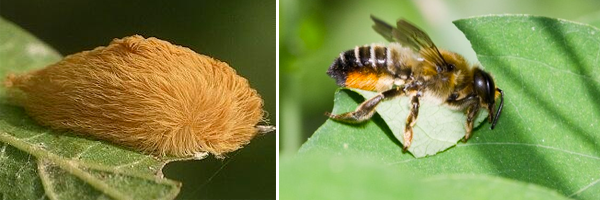The asps are out! It’s been years since we’ve had a big asp outbreak. These stinging hump back caterpillars love oak trees, yaupons hollies, burford hollies, hawthorns, altheas, and hibiscus. I saw a fresh hatching no bigger than a pea on some hollies the other day. Take a close look at your plants and see if you find any skeletonized leaves. Spray thoroughly on the tops and bottoms of the leaves with Spinosad, or Liquid Sevin as a contact kill. Thuricide can also be used, but the caterpillar has to ingest the leaves to be killed and that takes a couple of days.
Leafcutter bees are also a problem now. These bees are generally passive and not very aggressive. However they can sting and will do so if handled or aggravated. You usually never see the bee, but you do see the damage left behind. They cut perfect semi-circles out of the leaves of soft tissued plants such as crape myrtles, hibiscus, plumbago and roses. We first noticed the damage on our kapok trees. They take the leaves and roll them into perfect tubes to block their nest openings.  No treatment is necessary since the nesting period of the female is usually just a couple of weeks. The scalloping of the leaves will not kill your plants, it just leaves them unsightly to some. These bees are great pollinators, so I say, “let them do their thing”.
No treatment is necessary since the nesting period of the female is usually just a couple of weeks. The scalloping of the leaves will not kill your plants, it just leaves them unsightly to some. These bees are great pollinators, so I say, “let them do their thing”.
-DeAnna



Nell Angelo says
Do you carry Tanglefoot or another product to keep leaf cutter ants from stripping trees??
Jesse says
We carry a product called AmDro Total Ant Block that controls leaf cutter ants.
James Gill says
Amdro® was originally designed for fire ants, but with the addition of sugars, has become somewhat attractive to leaf-cutting ants. The bait is easily applied by mechanical spreader or by hand (wearing gloves) to the central nest area. Applications can be made in all seasons, but treatments should be postponed during periods of prolonged rain or freezing weather. Once the bait is applied, foraging ants search out the pellets and carry them underground. The first signs of control will be a reduction in foraging and excavation activity usually within 5 – 7 days after bait application. These activities will gradually stop and the colony will become inactive within 2 to 3 weeks.
Amdro leaf-cutting ant bait
Amdro® Ant Block is very safe to use. However, it has not proven to be as effective as methyl bromide or other baits in completely halting activity in leaf-cutting ant colonies. Only 3 of 10 colonies were killed with a single Amdro® bait application in a recent study by the Forest Pest Management Cooperative (D. Grosman, unpublished data). On the other hand, the activity of nearly all treated colonies was markedly reduced for several weeks. Although the worker ant activity of many colonies often recovers to a certain extent after 6 – 8 weeks, the activity almost never recovers to pretreatment levels. This suggests that the bait was effective in killing one or more queens and reduced the potential impact of colonies on crops or ornamentals.